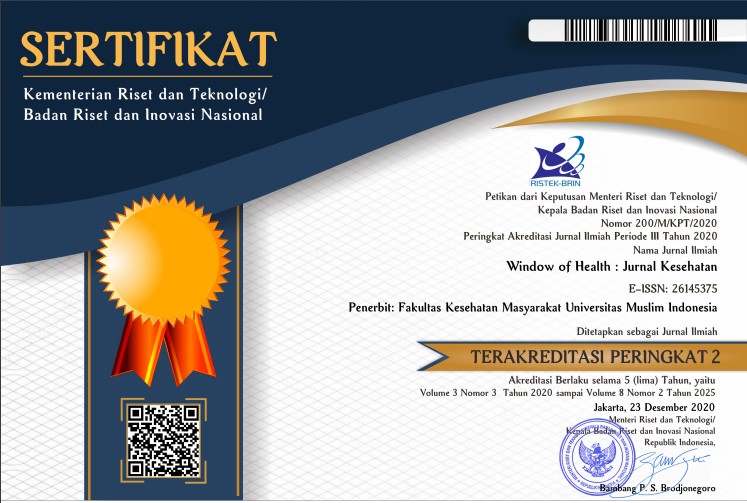Walking Exercise as an Alternative to Lose Weight and Blood Pressure in Women of Childbearing Age
Abstract
Hypertension or high blood pressure is the Silent Killer that can cause death slowly. Excessive fat accumulation in adipose tissue is obesity that can interfere with individual health. Women who are obese increase every year to 32.9%, caused by lifestyle factors that trigger the risk of obesity. Walking has the advantage of 5M (Mudah or easy, murah or cheap, Meriah or fun, masal or massive, and manfaat or benefits). People can do walking exercises without needing tools or trained people, can do it in groups cheerfully, and get health benefits. This study aimed to determine the effectiveness of walking exercise on body weight and blood pressure in women of reliable age (WUS). The method used a quasi-experimental pre-and post-test design with a control group, and two non-randomly chosen groups were intervention and control groups. The sample consisted of 36 women of reliable age with pre-hypertension, mild hypertension, and overweight and obesity. The results showed a significant difference in systolic and diastolic blood pressure after walking for 30 minutes 5 times a week, p-value 0.000. Walking is also suitable for decreasing Body Mass Index (BMI), with a p-value of 0.000. The conclusion is that walking affects blood pressure and body weight in patients with hypertension and obesity in women of reliable age. It is hoped that further research will provide interventions in a longer time, a larger number of research subjects, and control for other variables that affect blood pressure and BMI in women of childbearing age.
References
2. Catic Ar Zs, Vranic Jd, Lozo S. Age, Gender And Hypertension As Major Risk Fctors Indevelopment Of Subclinical Atherosclerosis. Journal Of Health Sciences. 2013;3:1.
3. RISKESDAS 2013. Jakarta: Kementrian Kesehatan RI. 2013.
4. (WHO) WHO. World health day: Control Your Blood pressure. Fact Sheet On Cardiovascular Diseases. 2013.
5. Kemenkes RI. 2012. Panduan Gerakan Nasional Sadar Gizi. Jakarta: Kementerian Kesehatan RI.
6. Rahmayanti R, Faktor-Faktor Resiko Maternal Yang Berhubungan Dengan Kejadian Preeklampsia Berat Pada Ibu Di Rsup Dr M Djamil Padang Pada Tahun 2010. J padang Fakultas Keperawatan Universitas Andalas. 2011.
7. Adiba S. Strategy Of Building Medical And Health Library Vetworking Though Ministry In Indonesia. 2017.
8. Shady Nw, Sallam Hf, Ali Ss, Abbas Am. The Efferct Of Regular Daily Walking On Adverse Pregnancy Outcomes Among Overweight Primigravidas: A Prospective Chort Study, J Proceedings In Obetetrics 2017;7(3):1-9.
9. Hosen, Mardijanto, S., & Novitasari, F. (2014). Perbedaan Tekanan Darah Sebelum dan Setelah Olahraga Jalan Kaki pada Lansia dengan Riwayat Hipertensi. Jurnal Kesehatan Dr. Soebandi, 4(1), 245–253.
10. Christina, F. A. (2019). Hubungan Kebiasaan Olahraga Dengan Tekanan Darah Pada Penderita Hipertensi Usia Produktif di Puskesmas Bergas. Repositori Universitas Ngudi Waluyo Ungaran, 1–10. Retrieved from http://repository2.unw.ac.id/id/eprint/255
11. Kristina, Pangaribuan, L., & Bisara, D. (2015). Hubungan Indeks Massa Tubuh dengan Hipertensi Pada Wanita Usai Subur (Analisis Data Riskesdas 2013). Jurnal Kesehatan Reproduksi, 6(2), 117–127.
12. Puspitasari, D. I., Hannan, M., & Chindy, L. D. (2017). Pengaruh Jalan Pagi terhadap Perubahan Tekanan Darah pada Lanjut Usia dengan Hipertensi di Desa Kalianget Timur Kecamatan Kalianget Kabupaten Sumenep. Jurnal Ners Lentera, 5(2), 169–177.
13. Taufik, M., Chakim, N., & Fajriyah, N. N. (2014). Tekanan Darah Ibu Hamil Primigavida Sebelum dan Sesudah melakukan Olahraga Jalan Kaki Selama Sepuluh Menit. Jurnal Ilmu Kesehatan, VI(I).
14. Rachma, Y. S. (2020). Pengaruh Latihan Fisik Terhadap Penurunan Berat Badan pada Kelompok Usia Dewasa dengan Status Gizi Lebih. Repositori Universitas Muhammadiyah Surakarta, 1–20.
15. Nurhayati, M., & Susanto, A. (2021). Menurunkan Berat Badan pada Wanita Usia Subur (WUS) Melalui Senam Aerobik Di Desa Cikoneng Kecamatan Sukahaji Kabupaten Majalengka. Bernas: Jurnal Pengabdian Kepada Masyarakat, 1(4), 720–723.
16. Dewantari, N. M., & Ambartana, I. W. (2017). Pengaruh Komposisi Diet dan Senam Aerobik terhadap Penurunan Berat Badan. Journal of The Indonesian Nutrition Association, 40(2), 59–68.
17. Hernández-Reyes, A., Cámara-Martos, F., Molina-Luque, R., Romero-Saldanã, M., Molina-Recio, G., & Moreno-Rojas, R. (2019). Changes in body composition with a hypocaloric diet combined with sedentary, moderate and high-intense physical activity: A randomized controlled trial. BMC Women’s Health, 19(1), 1–12. https://doi.org/10.1186/s12905-019-0864-5
18. Luglio, H. F., Sulistyoningrum, D. C., Apriliana, N. L., Putri, S. E., Larasati, A., Tsani, A. F. A., … Huriyati, E. (2017). The effect of combined aerobic and strength training on a weight loss and metabolic profile: Development of an effective lifestyle-based weight loss program. Topics in Clinical Nutrition, 32(2), 152–160. https://doi.org/10.1097/TIN.0000000000000100
19. Sientia, F. (2012). Pengaruh Latihan Senam Aerobik terhadap Perubahan Berat Badan pada Peserta Klub Kebugaran. Jurnal Kedokteran Dip, 1(105261).
Copyright (c) 2023 Erni Juniartati, Sarliana Zaini, Suhariyanto Suhariyanto

This work is licensed under a Creative Commons Attribution-NonCommercial-ShareAlike 4.0 International License.








